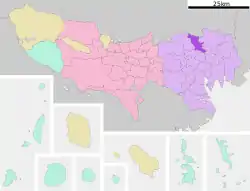Kyū-Furukawa Gardens
Kyū-Furukawa Gardens (旧古河庭園, kyū-furukawa teien) is a Tokyo metropolitan park in Nishigahara, Kita, Tokyo. The park includes an old western-style mansion with a rose garden, and a Japanese garden which were built in early 20th century.
| Kyū-Furukawa Gardens | |
|---|---|
2.jpg.webp) Mansion in the gardens | |
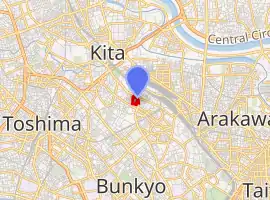
| |
| Location | Kita, Tokyo, Japan |
| Coordinates | 35.742557°N 139.746159°E |
| Area | 30,780.86 square metres (331,322.4 sq ft) |
| Created | 30 April 1956 |
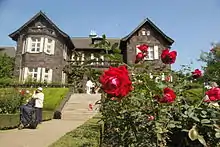
Outline
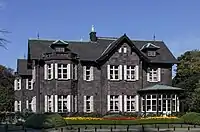
This mansion was built by Baron Toranosuke Furukawa, which includes a western-style building and a western-style garden, and a Japanese-style garden. The western-style building and western-style gardens were completed in 1917, which were designed by English architect Josiah Conder (1852-1920). Conder was called "father of Japanese modern architecture" and also designed Rokumeikan and Kyu-Iwasaki-tei Garden, Holy Resurrection Cathedral. And the Japanese garden was completed in 1919, which was designed by Japanese-gardener Ogawa Jihei VII.
Baron Furukawa was the owner of Furukawa zaibatu which owned Ashio copper mine .
Western building and garden

The outlook of the building is completely Western-style, and the ground floor rooms are also western-style, but the second floor rooms are mostly in Japanese style with tatami matless. The mansion is built on a steep slope of Musashino Terrace. The building is located on the top of a hill, western-garden on the slope, and Japanese garden on the bottom. The western garden is a complex of Italian style and geometric French style rose garden. On the bottom of the western garden is a Rhododendron plantation which harmonise the western geometric garden and non geometric Japanese garden.
Japanese garden
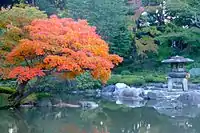
The Japanese garden is surrounded by a deep forest. The Western building and garden are hidden by tall trees. In the centre of the stroll garden is an artificial pond called "Shin- ji- ike" which means "Heart letter pond", because its pattern is designed by Kanji "心(Shin)" which means heart. Around the pond are Tōrōs (stone lanterns), artificial hill, water falls, islands, and a tea ceremony house.[1] The park in its current state was opened to the public in 1956.
Access
General admission is 150 yen. The park is open daily until 5 PM. It is a quick walk from Kami-Nakazato Station on the JR Keihin-Tōhoku Line or Nishigahara Station on the Tokyo Metro Nanboku Line
Popular Culture
The garden guesthouse features in the popular series Umineko When They Cry.
See also
- Parks and gardens in Tokyo
References
- "Harmony of western garden and Japanese garden". Archived from the original on 7 April 2006. Retrieved 4 September 2011.
| Wikimedia Commons has media related to Kyu-Furukawa Gardens. |
